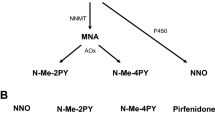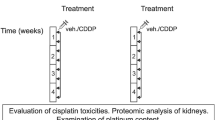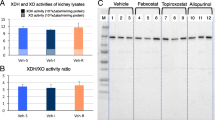Abstract
Intracellular catabolism of NAD in mammalian cells occurs mainly via reaction catalyzed by poly(ADP-ribose) polymerase (PARP) with the release of nicotinamide, which is then metabolized predominantly to N-methyl-2-pyridone-5-carboxamide (2PY). PARP could be activated by binding to broken DNA and is known to be involved in DNA repair mechanisms, cell stress response and regulation of apoptosis. 2PY may accumulate under disease conditions resulting in accelerated DNA damage and retention of catabolic products. Our hypothesis was that chronic renal failure would lead to elevation of 2PY and potentially to inhibition of PARP and related physiological mechanisms. In the present study we: (a) compared plasma 2PY concentration in healthy subjects and in patients with chronic renal failure (CRF); (b) evaluated the relationship between plasma 2PY concentration and the severity of CRF; (c) evaluated the effect of hemodialysis treatment and kidney transplantation on 2PY concentration.
We found that the plasma 2PY concentration in healthy subjects is 0.83 ± 0.18 μM but it could increase up to 40 μM in patients with CRF. A significant correlation was found in CRF between plasma 2PY and creatinine concentration. A single hemodialysis treatment was associated with significant reduction of plasma 2PY concentration after the hemodialysis, but it increased rapidly 48 h after the end of treatment. Successful kidney transplantation was associated with return of 2PY concentration to the normal range.
In conclusion, our results indicated significant production of 2PY in humans. In healthy subjects 2PY is cleared from the plasma by excretion in the urine. Altered excretion by the kidney leads to increase in plasma concentration of 2PY. It is possible that 2PY may play a significant role in the development of uremic toxemia, especially as an inhibitor of poly(ADP-ribose)polymerase.
Similar content being viewed by others
References
Stratford MR, Dennis MF: High-performance liquid chromatographic determination of nicotinamide and its metabolites in human and murine plasma and urine. J Chromatogr 582: 145–151, 1992
Shibata K, Toda S: Effects of sex hormones on the metabolism of tryptophan to niacin and to serotonin in male rats. Biosci Biotechnol Biochem 61: 1200–1202, 1997
D'Amours D, Desnoyers S, S'silva I, Poirier GG: Poly(ADP-ribosyl) reactions in the regulation of nuclear functions. Biochem J 342: 249–268, 1999
Jacobson MK, Jacobson EL: Discovering new ADP-ribose polymer cycles: protecting the genome and more. Trends Biochem Sci 24: 415–417, 1999
Devlin TM: In: Textbook of Biochemistry with Clinical Correlations. Wiley-Liss, Inc., New York, 1992, pp 561–562
Smith S: The world according to PARP. Trends in Biochem Sci 26: 174–179, 2001
Goodwin POM, Lewis PJ, Davies MI, Skidmore CJ, Shall S: The effect of gamma radiation and neocarzinostatin on NAD and ATP levels in mouse leukemia cells Biochim Biophys Acta 543: 576–582, 1978
Skidmore CJ, Davies MI, Goodwin PM, Halldorson H, Lewis PJ, Shall S, Zia'ee AA: The involvement of poly(ADP-ribose)polymerase in the degradation of NAD caused by gamma radiation and N-methyl-Nnitrosourea. Eur J Biochem 101: 135–142, 1979
Yamanaka H, Penning CA, Wullis EH, Wasson DB, Carson DA: Characterization of human poly(ADP-ribose)polymerase with autoantibodies. J Biol Chem 263: 3879–3883, 1988
Ludwig A, Behnke B, Holtlund J, Hilz H: Immunoquantitaion and size determination of intrinsic poly(ADP-ribose)polymerase from acid precipitates. Analysis of the in vivo status in mammalian species and in lower eukaryotes. J Biol Chem 263: 6993–6999, 1988
Shieh WM, Ame JC, Wilson MV, Wang ZQ, Koh DW, Jacobson MK, Jacobson EL: Poly(ADP-ribose)polymerase null mouse cells synthesis ADP-ribose polymers. J Biol Chem 273: 30069–30072, 1998
Gillmor HA, Bolton CH, Hopton M, Moore WPT, Perrett D, Bingley PJ, Gale EAM: Measurement of nicotinamide and N-methyl-2-pyridone-5-carboxamide in plasma by high performance liquid chromatography. Biomed Chromatogr 13: 360–362, 1999
Tarng DC, Huang TP, Liu TY, Chen HW, Sung YJ, Wei YH: Effect of vitamin E-bonded membrane on the 8-hydroxy-2′-deoxyguanosine level in leukocyte DNA of hemodialysis patients. Kidney Int 58: 790–799, 2000
Tarng DC, Huang TP, Wei YH, Liu TY, Chen HW, Wen Chen T, Yang WC: 8-hydroxy-2′-deoxyguanosine of leukocyte DNA as a marker of oxidative stress in chronic hemodialysis patients. Am J Kidney Dis 36: 934–944, 2000
Marlewski M, Smolenski RT, Szolkiewicz M, Aleksandrowicz Z, Rutkowski B, Swierczynski J: Increased rate of adenine incorporation into adenine nucleotide pool in erythrocytes of patients with chronic renal failure. Nephron 86: 281–286, 2000
Smolenski RT, Lachno DR, Ledingham SJM, Yacoub MH: Determination of sixteen nucleotides, nucleosides and bases using high-performance liquid chromatography and its application to the study of purine metabolism in hearts for transplantation. J Chromatogr 527: 414–420, 1990
Menissier-de Murcia J, Molinete M, Gradwohl G, Simonin F, de Murcia G: Zinc-binding domain of poly(ADP-ribose)polymerase participates in the recognition of single strand breaks on DNA. J Mol Biol 210: 229–233, 1989
Benjamin RC, Gill DM: ADP-ribosylation in mammalian cell ghosts. Dependence of poly (ADP-ribose) synthesis on strand breakage in DNA. J Biol Chem 255: 10493–10501, 1980
Pieper AA, Verna A, Zhang J, Snyder SH: Poly(ADP-ribose)-polymerase, nitric oxide and cell death. Trends Pharmacol Sci 20: 171–181, 1999
Pieper AA, Walles T, Wei G, Clements EE, Verna A, Snyder SH, Zweier JL: Myocardial postischemic injury is reduced by poly(ADPribose) polymerase-1 gene disruption. Mol Med 6: 271–282, 2000
Zhang J, Pieper AA, Snyder SH: Poly(ADP-ribose) synthetase activation: An early indicator of neurotoxic DNA damage. J Neurochem 65: 1411–1414, 1995
Rut A, de Murcia G, Schulz GE: Inhibitor and NAD+ binding to poly(ADP-ribose)polymerase as derived from crystal structures and homology modeling. Biochemistry 37: 3893–3900, 1998
Virag L, Szabo C: Purines inhibit poly(ADP-ribose)polymerase activation and modulate oxidant-induced cell death. FASEB J 15: 99–107, 2001
Althans FR, Richter C: ADP-ribosylation of proteins. Enzymology and biological significance. Mol Biol Biochem Biophys 37: 1–237, 1987
Maisonneuve P, Agodoa L, Gellert R, Stewart JH, Buccianti G, Lowenfels AB, Wolfe RA, Jones E, Disney APS, Briggs D, McCredie M, Boyle P: Cancer in patients on dialysis for end-stage renal disease: An international collaborative study. Lancet 354: 93–99, 1999
Rights and permissions
About this article
Cite this article
Slominska, E.M., Smolenski, R.T., Szolkiewicz, M. et al. Accumulation of plasma N-methyl-2-pyridone-5-carboxamide in patients with chronic renal failure. Mol Cell Biochem 231, 83–88 (2002). https://doi.org/10.1023/A:1014445329756
Issue Date:
DOI: https://doi.org/10.1023/A:1014445329756




